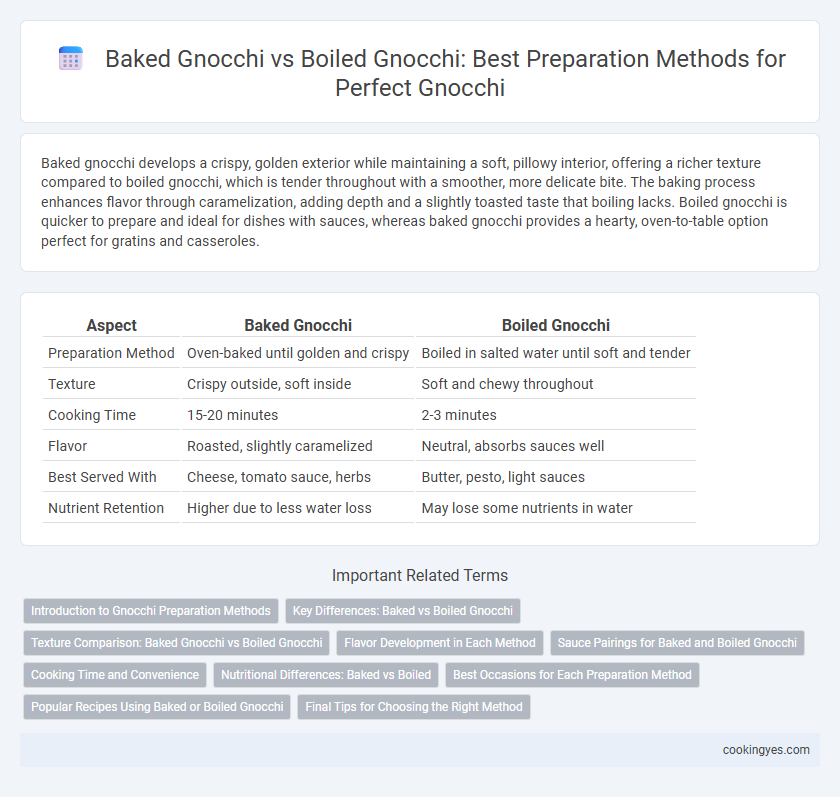Baked gnocchi develops a crispy, golden exterior while maintaining a soft, pillowy interior, offering a richer texture compared to boiled gnocchi, which is tender throughout with a smoother, more delicate bite. The baking process enhances flavor through caramelization, adding depth and a slightly toasted taste that boiling lacks. Boiled gnocchi is quicker to prepare and ideal for dishes with sauces, whereas baked gnocchi provides a hearty, oven-to-table option perfect for gratins and casseroles.
Table of Comparison
| Aspect | Baked Gnocchi | Boiled Gnocchi |
|---|---|---|
| Preparation Method | Oven-baked until golden and crispy | Boiled in salted water until soft and tender |
| Texture | Crispy outside, soft inside | Soft and chewy throughout |
| Cooking Time | 15-20 minutes | 2-3 minutes |
| Flavor | Roasted, slightly caramelized | Neutral, absorbs sauces well |
| Best Served With | Cheese, tomato sauce, herbs | Butter, pesto, light sauces |
| Nutrient Retention | Higher due to less water loss | May lose some nutrients in water |
Introduction to Gnocchi Preparation Methods
Baked gnocchi offers a crispy exterior and a slightly toasted flavor, achieved by cooking the potato dumplings in the oven with sauce and cheese, enhancing texture and taste complexity. Boiled gnocchi, the traditional method, involves quickly cooking the dumplings in boiling water until they float, resulting in a soft and pillowy texture ideal for absorbing sauces. Understanding these preparation methods allows for versatile use of gnocchi in various recipes, balancing between creamy softness and oven-baked crispiness.
Key Differences: Baked vs Boiled Gnocchi
Baked gnocchi offers a crispy, golden exterior with a tender interior, achieved by roasting in the oven, while boiled gnocchi provides a soft, pillowy texture by cooking in boiling water. The baking method enhances flavor through caramelization and allows for layering with sauces and cheese, creating a gratin-like dish. Boiled gnocchi requires timely draining to prevent sogginess and is best served immediately with light sauces to maintain its delicate texture.
Texture Comparison: Baked Gnocchi vs Boiled Gnocchi
Baked gnocchi develops a crispy exterior with a tender, slightly chewy interior, creating a satisfying contrast in texture that enhances each bite. Boiled gnocchi delivers a soft, pillowy texture throughout, resulting in a delicate and fluffy mouthfeel. The choice between baked and boiled preparation methods significantly influences the overall eating experience, with baking adding a desirable crunch and boiling preserving a smooth, tender consistency.
Flavor Development in Each Method
Baked gnocchi develops a richer, caramelized flavor due to the Maillard reaction, which creates crispy edges and a golden crust that enhances texture and taste complexity. Boiled gnocchi retain a softer, pillowy consistency, emphasizing the delicate potato flavor without the added caramelization from dry heat. Each method influences the sensory profile, with baking intensifying savory notes while boiling highlights the gnocchi's inherent subtlety.
Sauce Pairings for Baked and Boiled Gnocchi
Baked gnocchi pairs exceptionally well with rich, creamy sauces like Alfredo or bechamel, which complement the crispy exterior and soft interior by coating each piece with smooth, velvety texture. Boiled gnocchi absorb lighter, broth-based sauces such as marinara or pesto, allowing the delicate potato pasta to soak up fresh, herbaceous flavors and maintain a tender bite. Choosing sauce pairings based on preparation enhances the overall dish, with baked gnocchi benefiting from thicker sauces and boiled gnocchi thriving with more fluid, aromatic options.
Cooking Time and Convenience
Baked gnocchi typically requires a longer cooking time of around 25-30 minutes, offering a crispy outer texture and a soft interior, while boiled gnocchi cooks in just 2-3 minutes, making it a quicker option. Boiling gnocchi is convenient for rapid meal preparation, allowing immediate serving once they float to the surface, indicating doneness. Baked gnocchi demands extra steps like sauteing or layering with sauce, which may extend prep time and require more attention during cooking.
Nutritional Differences: Baked vs Boiled
Baked gnocchi typically retains more nutrients due to less water exposure, preserving vitamins such as B-complex and minerals like potassium. Boiled gnocchi may lose some water-soluble vitamins and minerals in the cooking water, resulting in slightly lower nutritional content. Calorie counts can vary, with baked gnocchi often containing less added fat if prepared without excessive oil, whereas boiled versions sometimes require additional sauces for flavor enhancement.
Best Occasions for Each Preparation Method
Baked gnocchi offers a golden, crispy texture ideal for hearty family dinners or festive occasions where a rich, comforting dish is desired. Boiled gnocchi provides a soft and tender bite perfect for quick weeknight meals or light lunches paired with simple sauces like pesto or marinara. Each preparation method caters to different dining experiences, with baked gnocchi suited for oven-baked gratins and boiled gnocchi excelling in traditional Italian pasta dishes.
Popular Recipes Using Baked or Boiled Gnocchi
Baked gnocchi recipes often feature rich tomato sauces and melted cheese, creating a crispy, golden crust that enhances texture and flavor, as seen in dishes like baked gnocchi al forno. Boiled gnocchi are commonly tossed with buttery sage sauce or creamy Alfredo, emphasizing softness and tenderness, ideal for classic Italian meals like gnocchi alla sorrentina. Both methods offer versatile bases for recipes incorporating ingredients such as spinach, mushrooms, or sausage, catering to diverse culinary preferences.
Final Tips for Choosing the Right Method
Baked gnocchi offers a crispy exterior and a richer, layered flavor ideal for casseroles and dishes requiring added texture, while boiled gnocchi provides a soft, pillowy consistency perfect for delicate sauces and quick meals. Consider the desired texture and cooking time when choosing the preparation method; baking requires longer cooking with added ingredients, whereas boiling is faster and preserves the lightness of the potato dough. For best results, use high-quality, starchy potatoes and avoid over-handling the dough to ensure tender gnocchi regardless of the cooking technique.
Baked gnocchi vs boiled gnocchi for preparation method Infographic

 cookingyes.com
cookingyes.com